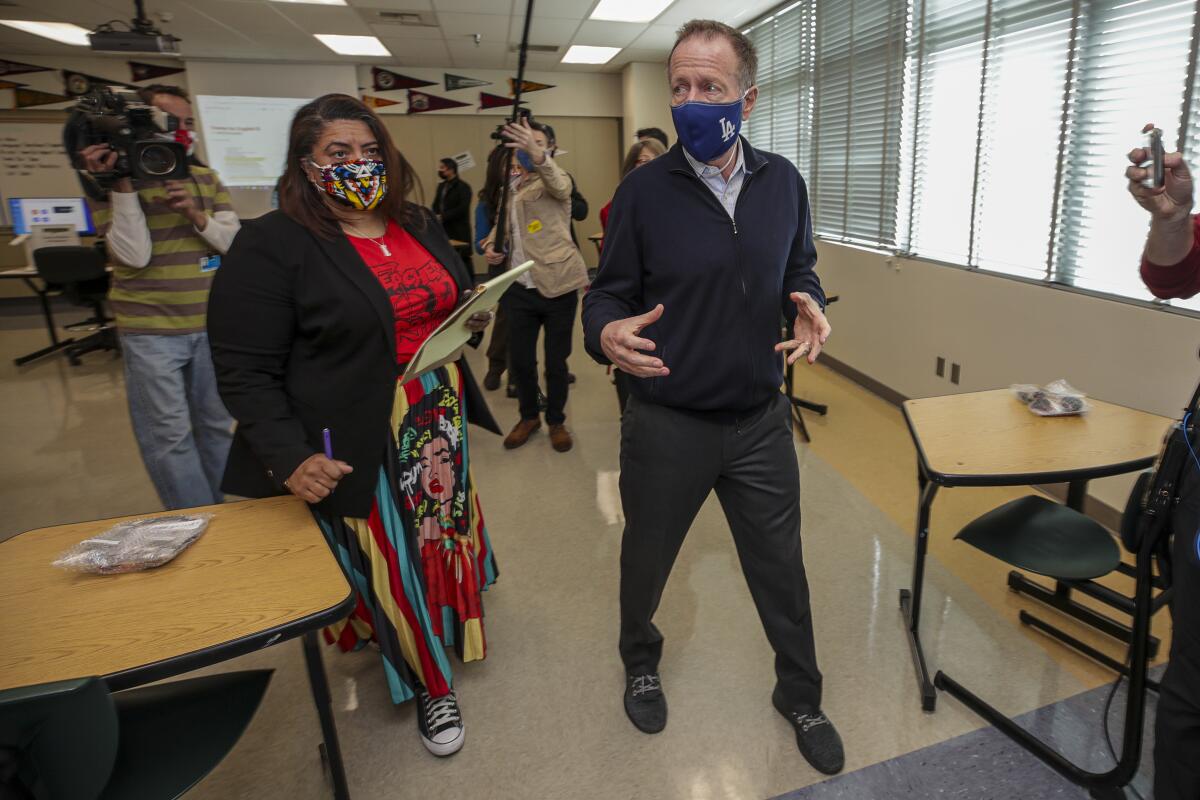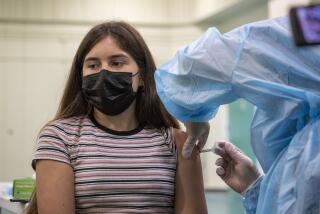L.A. school board approves deal with teachers to reopen campuses by mid-April

- Share via
The Los Angeles school board on Thursday unanimously approved a deal with the teachers union that aims to reopen elementary schools in mid-April and middle and high schools in late April or early May.
Members of the union will vote on ratifying the agreement next week.
The L.A. Board of Education voted 7 to 0 at the conclusion of a more than two-hour meeting that brought out more details related to how schools would operate.
The agreement offers some good news for working parents of younger students: Students in transitional kindergarten through eighth grade can remain on campus from 8 a.m. to 4 p.m. five days a week. The caveat is that at least half of the instruction will either remain online or be spent on work that does not involve live interaction with a teacher.
Elementary school students would have the option of returning to campus Monday through Friday for three hours of live, in-person interaction with their teacher and classmates. In-person classes will take place during the morning session, and an early-afternoon session would be for students who remain in full-time distance learning.
Children who attended in person in the morning could either go home or move to on-campus day care in the afternoon. All would have assignments to complete during the hours of the school day they are not with their teacher.
District officials also have sent out surveys, due March 19, asking families whether they intend to return their children to campus. Families will not be locked into their decision, but principals need to hear from parents for planning purposes as soon as possible, Chief Academic Officer Alison Yoshimoto-Towery said.
“We ask you to kind of put a stake in the ground and give us your best guess,” Yoshimoto-Towery said during the broadcast of the board meeting.
Without this information, “it’s like we’ve been planning a wedding with no guest lists,” human resources chief Linda Del Cueto said.
Under the agreement, teachers will not be required to teach online and in person simultaneously. All employees will have access to COVID-19 vaccinations and the time needed to achieve maximum immunity — hence the mid-April start date. No one can be legally required to take the vaccine, because it is currently being provided under a federal emergency use authorization. Teachers with a verified health risk will be allowed to continue teaching from home at all times, and a substitute will provide additional support for students in that class who return to campus.
A survey also is going out to determine what teachers want to do.
Once campuses reopen, there is not a limit on the size of the class, but there has to be enough room to provide six feet between students. As a result, a typical classroom might accommodate only 12 to 14 people at a time, leading to the staggered, part-time in-person schedules.
Of course, there are likely to be additional complications — such as a larger-than-expected number of students wanting to return to a particular class. In that situation, a school could move those classes to larger rooms or take instruction outdoors under a tent.
“We’re doing everything possible to not reorganize classrooms,” Del Cueto said.
For middle and high school parents, the meeting included additional explanation of a format that has disappointed many. For these students, returning to campus will mean moving from Zoom at home to Zoom in a classroom. Families will have the option of a schedule that would provide two days a week on campus followed by three days a week on campus.
Students would remain in their advisory class for the entire day. Lunch would be outside, but no mixing would be allowed with students from other groups.
During one period a day, the advisory teacher and students would work together on assignments and activities unrelated to core academic work. These activities would focus on students’ social and emotional well-being.
Every student will don noise-canceling headphones for their online classes, although, presumably, they will speak out from time to time as they participate in class discussions. Meanwhile, the supervising teachers will be conducting their own classes to students connected online in other rooms.
This solution was driven by a decision to avoid mixing groups of students and changing the complex master schedules of middle and high schools so close to the end of the academic year.
The format makes sense, said board member Jackie Goldberg, a retired teacher, but it’s far from ideal.
“Being a secondary teacher myself, I can tell you that this would be devastating,” Goldberg said, “but I do want to say to you that it is rather important that if I have had students all year till the end of April, that you not: (a) give me a different group of students and (b) tell those students they can’t keep me as their teacher.”
She added: “I know everybody’s unhappy. I’m unhappy … unhappy that that’s all that’s allowed right now under the current course of the pandemic.”
Health guidelines permit larger groups of students and class changes, but the district and union were unwilling to make that trade-off at the expense of their interpretation of safety imperatives.
“No one thinks hybrid is pedagogically ideal — it’s a compromise because of health constraints,” said board member Nick Melvoin, who added that he was trying to imagine how his animated style as a middle school teacher would have worked in this situation.
Teachers, who already had to adapt instantly to online methods, would have the burden of quickly adapting again, he said.
Board members noted they’d been hearing an earful from parents of older students.
More to Read
Sign up for Essential California
The most important California stories and recommendations in your inbox every morning.
You may occasionally receive promotional content from the Los Angeles Times.











